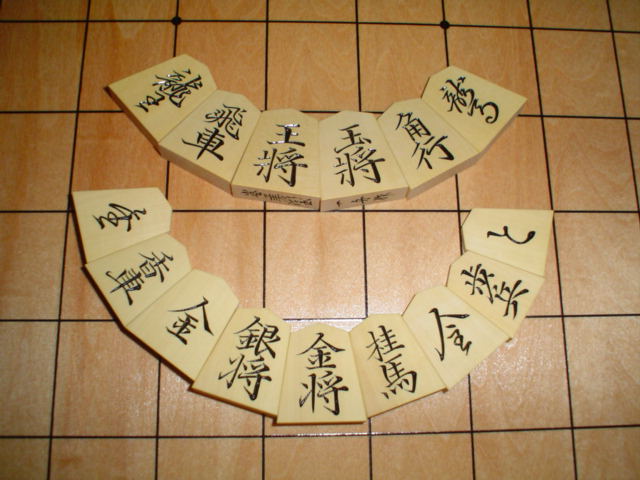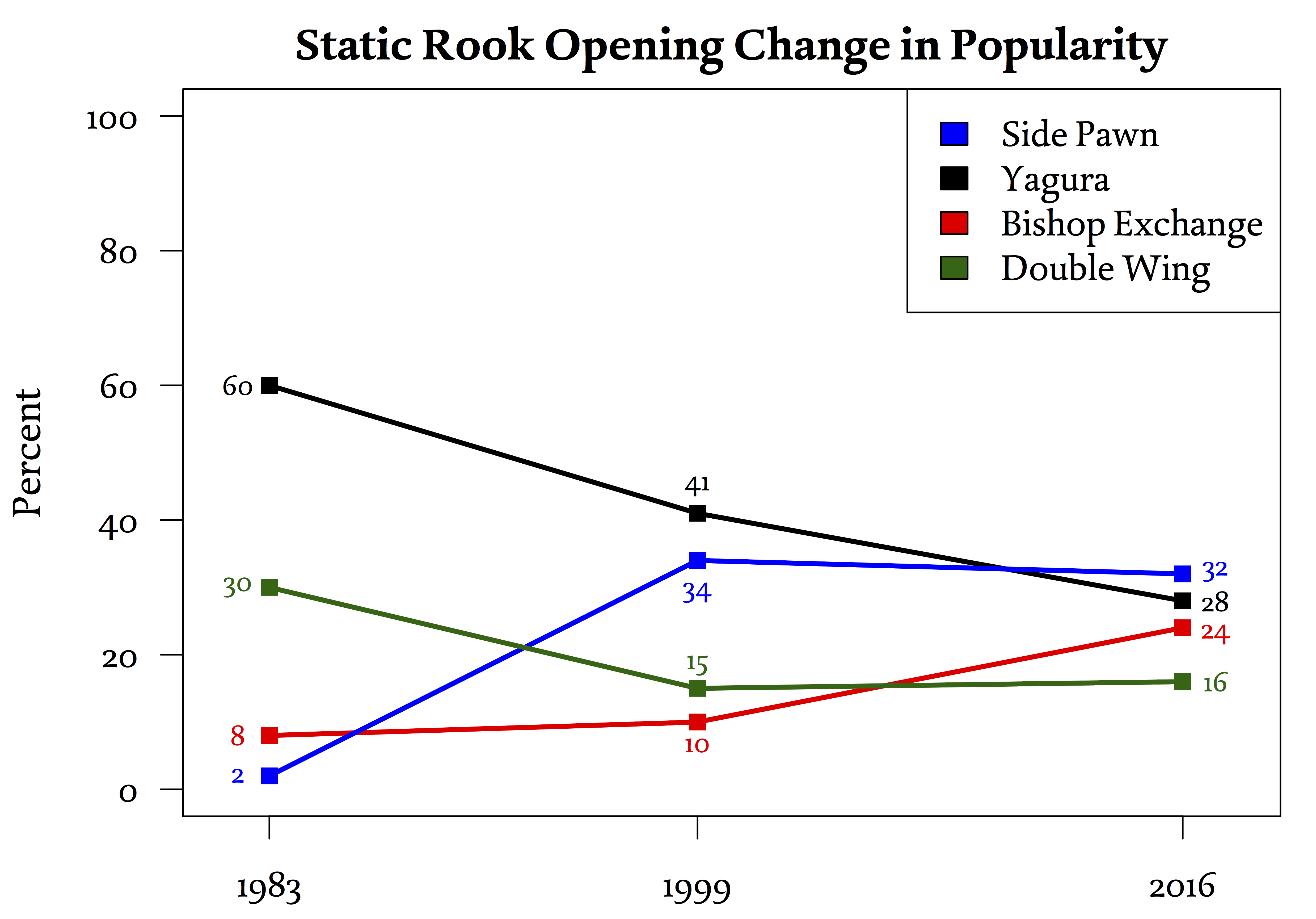|
Quick Ishida
In shogi, Quick Ishida, Rapid Ishida or Ishida Quick Attack (早石田 ''haya ishida'') is an Ishida variation of the Third File Rook class of openings characterized by an open bishop diagonal. Like all Ishida variations, it has an early advancement of seventh file pawn when played by Black or third file pawn when played by White. The strategy initially has the Static Rook opponent aiming to attack the Ishida player's bishop head and while the Ishida player aims to counterattack breaking Static Rook's camp on the seventh file with the threat of several different bishop drop positions. The Quick Ishida position can lead to a number of traps if the opponent does not defend properly. Initial positioning 1. P-76. The most common and most flexible first move found in shogi games. A player intending on a Quick Ishida position must open their bishop diagonal with P-76 on their first move since they will need to push this pawn up to the middle rank 5 on their next move. ... [...More Info...] [...Related Items...] OR: [Wikipedia] [Google] [Baidu] |
Shogi
, also known as Japanese chess, is a strategy board game for two players. It is one of the most popular board games in Japan and is in the same family of games as Western chess, ''chaturanga, Xiangqi'', Indian chess, and '' janggi''. ''Shōgi'' means general's (''shō'' ) board game (''gi'' ). Western chess is sometimes called (''Seiyō Shōgi'' ) in Japan. Shogi was the earliest chess-related historical game to allow captured pieces to be returned to the board by the capturing player. This drop rule is speculated to have been invented in the 15th century and possibly connected to the practice of 15th century mercenaries switching loyalties when captured instead of being killed. The earliest predecessor of the game, chaturanga, originated in India in the sixth century, and the game was likely transmitted to Japan via China or Korea sometime after the Nara period."Shogi". ''Encyclopædia Britannica''. 2002. Shogi in its present form was played as early as the 16th century, while ... [...More Info...] [...Related Items...] OR: [Wikipedia] [Google] [Baidu] |
Daisuke Suzuki (shogi)
is a Japanese professional shogi player ranked 9-dan. He is currently an executive director of the Japan Shogi Association. Early life Daisuke Suzuki was born in Machida, Tokyo on July 11, 1974. He won the 11th tournament in 1986, defeating fellow future shogi professional Toshiaki Kubo in the semi-final round. In June 1986, Suzuki entered the Japan Shogi Association's apprentice school at the rank of 6-kyū as a protegee of shogi professional Nobuyuki Ōuchi. He was promoted to 1-dan in October 1988, and then obtained full professional status and the rank of 4-dan in October 1994. Shogi professional Suzuki's first tournament victory as a professional came in 1996 when he defeated Takashi Abe to win the 15th tournament. In March 1999, he defeated Masataka Gōda to win the 49th NHK Shogi TV Tournament for his only other tournament victory. In October 1999, Suzuki made his first appearance in a major title match as the challenger to Takeshi Fujii for the 12th Ryūō title, ... [...More Info...] [...Related Items...] OR: [Wikipedia] [Google] [Baidu] |
Shogi Openings
, also known as Japanese chess, is a Abstract strategy game, strategy board game for two players. It is one of the most popular board games in Japan and is in the same family of games as chess, Western chess, ''chaturanga, Xiangqi'', Indian chess, and ''janggi''. ''Shōgi'' means general's (''shō'' ) board game (''gi'' ). Western chess is sometimes called (''Seiyō Shōgi'' ) in Japan. Shogi was the earliest chess-related historical game to allow captured pieces to be returned to the board by the capturing player. This drop rule is speculated to have been invented in the 15th century and possibly connected to the practice of 15th century Mercenary#15th to 18th centuries, mercenaries switching loyalties when captured instead of being killed. The earliest predecessor of the game, chaturanga, originated in India in the sixth century, and the game was likely transmitted to Japan via China or Korea sometime after the Nara period."Shogi". ''Encyclopædia Britannica''. 2002. Shogi in ... [...More Info...] [...Related Items...] OR: [Wikipedia] [Google] [Baidu] |
Shogi Opening
A shogi opening ( ) is the sequence of initial moves of a shogi game before the middle game. The more general Japanese term for the beginning of the game is ()''.'' A '' jōseki'' () is the especially recommended sequence of moves for a given opening that was considered balanced play at one point in time for both sides by professional players. (However, some ''s'' have become outdated when they are reevaluated to no longer give balanced play.) ''s'' also typically include commentary about the possible reasons to deviate from the especially regarding blunders. Note that not all openings have ''s''. For example, trap openings like Demon Slayer, while they may have standard moves, are considered to favor one player and are not balanced play. Thus, the Demon Slayer opening is not a jōseki. Introduction The very first opening moves in most games are pawn pushes. In particular, most games start with two types of pawn pushes. A player can move the rook pawn forward (P-26) ... [...More Info...] [...Related Items...] OR: [Wikipedia] [Google] [Baidu] |
Ranging Rook
Ranging Rook or Swinging Rook (振り飛車 ''furibisha'') openings in shogi position the rook to the center or left of the player's board to support an attack there. Ranging Rook strategies used in Ranging Rook vs Static Rook are among the oldest of shogi strategies attested in the historical documents that first describe the rules of shogi around 1600. Description Types of Ranging Rook Traditionally, Ranging Rook has been used as a defensive strategy for White against Static Rook openings played by Black. White's rook can be moved flexibly to counteract Black's attacks. These types of White openings are named simply Ranging Rook (振り飛車 ''furibisha''). In describing the game positions of both opponents, the term is Static Rook vs Ranging Rook (居飛車対振り飛車 ''ibisha tai furibisha''). In these games, Black has the initiative, and White quickly builds a defense by castling the king and seeks counterattacking opportunities. By default, the ... [...More Info...] [...Related Items...] OR: [Wikipedia] [Google] [Baidu] |
Meijin (shogi)
is one of the eight titles in Japanese professional shogi, and is the most prestigious title, along with Ryūō. The word ''meijin'' (名 ''mei'' "excellent, artful", 人 ''jin'' "person") refers to a highly skilled master of a certain field (the various arts found in traditional Japanese culture, such as the Japanese tea ceremony, go, competitive karuta, rakugo, budō). History The Meijin institution started in the 17th century (Edo period), and for around 300 years (1612–1937) was a hereditary title that was passed from the reigning Meijin upon his retirement or death to another selected from three families, as deemed to be worthy. This is known as the Lifetime Meijin system (終生名人制). In 1935, however, the Japan Shogi Association, or JSA, announced that it was abolishing the existing system of succession in favor of something more short-term and reflective of actual playing strength, known as the Real Strength Meijin system (実力名人制). In 1937, the reigni ... [...More Info...] [...Related Items...] OR: [Wikipedia] [Google] [Baidu] |
Kōzō Masuda
was a Japanese professional shogi player who achieved the rank of 9-dan. He is a former Meijin who was known for playing very creative shogi. For instance, top player Yoshiharu Habu considered Masuda's playing style to be 30 years ahead of its time and the origin of the modern way to play shogi. Kōzō Masuda Award Each year since 1995 the Japan Shogi Association The , or JSA, is the primary organizing body for professional shogi in Japan. The JSA sets the professional calendar, negotiates sponsorship and media promotion deals, helps organize tournaments and title matches, publishes shogi-related materia ... has awarded the Kōzō Masuda Award (升田幸三賞 ''Masuda Kōzō Shō'') to the player or players whose innovative new ideas in shogi theory or tactics, or whose new or excellent moves have attracted significant attention among other shogi players and fans during the year. A second award is the Masuda Special Prize (升田幸三賞特別賞), which is given out i ... [...More Info...] [...Related Items...] OR: [Wikipedia] [Google] [Baidu] |
Climbing Silver
Climbing Silver (棒銀 ''bōgin'', literally "pole-silver") is a shogi strategy. Climbing Silver involves advancing a silver upward along with an advanced or dropped pawn supported by the rook aiming to break through the opponent's camp on their bishop's side. Many different Static Rook shogi openings include a Climbing Silver component. For instance, Climbing Silver can played as part of Double Wing Attack, Fortress, or Bishop Exchange openings. (However, there are other variants of these openings that don't include Climbing Silver.) Climbing Silver can also be used against Ranging Rook opponents as well. Diagonal Climbing Silver or Oblique Climbing Silver (斜め棒銀 ''naname bōgin'') is a Climbing Silver attack involving the left silver which moves diagonally from its starting position on 7i to attack on the third or second files. This type of Climbing Silver is typical in Static Rook vs Ranging Rook games. Positioning In the adjacent diagrams, the Black's ... [...More Info...] [...Related Items...] OR: [Wikipedia] [Google] [Baidu] |
Ishida (shogi)
The ''Ishida'' Opening (石田流三間飛車 ''ishida-ryū sankenbisha'' or shorter form 石田流 ''ishida-ryū'') is a major variation in Third File Rook openings of the Japanese game of '' shōgi''. In the Ishida Opening, in contrast to other Third File Rook openings, the seventh file pawn is advanced to the fifth rank if played by Black (P-75), or the third file pawn if played by White (P-35). This allows the rook to move up to the 76 square (Black) or 34 square (White). History The variation is said to have originated with a blind ''shōgi'' player named Kengyo Ishida in the early Edo period. Although records of Ishida's actual games still exist, all of them end in Ishida's loss. An extant game record of a Double Ranging Rook game in 1649 featuring an Ishida position played by Kengyo Ishida is shown in the diagram. A renaissance of the Ishida variation occurred in the 1970s through the development of an original strategy by the well-known ''shōgi'' master Kōzō Masud ... [...More Info...] [...Related Items...] OR: [Wikipedia] [Google] [Baidu] |
Blunder (chess)
In chess, a blunder is a critically bad move. It is usually caused by some tactical oversight, whether it be from time trouble, overconfidence or carelessness. Although blunders are most common in amateur games, all human players make them, even at the world championship level. Creating opportunities for the opponent to blunder is an important skill in chess. What qualifies as a "blunder" rather than a normal mistake is somewhat subjective. A weak move from a novice player might be explained by the player's lack of skill, while the same move from a master might be called a blunder. In chess annotation, blunders are typically marked with a double question mark, "", after the move. Especially among amateur and novice players, blunders often occur because of a faulty thought process where players do not consider the opponent's . In particular, checks, , and need to be considered at each move. Neglecting these possibilities leaves a player vulnerable to simple tactical errors. One ... [...More Info...] [...Related Items...] OR: [Wikipedia] [Google] [Baidu] |


